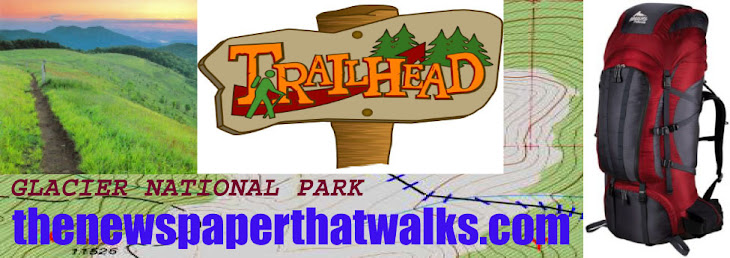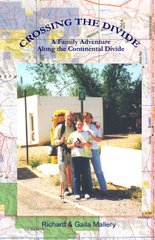By ERIC NEWHOUSE
Six backcountry hikers have disappeared without a trace and presumably died in Glacier National Park in the past century, according to park archives. Last week, Yi-Jien Hwa, a college student from Kentucky who is originally from Malaysia, was added to that list.
Hwa set off on an ambitious 96-mile hike through some of the most dangerous sections of Glacier Park on Aug. 11 — against the recommendations of park officials — and hasn't been seen since."We've been investigating whether he went in on the route he had chosen, whether he went in on a different route or whether he never went in at all," park spokeswoman Norma Sosa said.Incident commander Patrick Suddath, who led an exhaustive search for the missing hiker, is fairly sure Hwa started his trek."We think whatever happened to him happened on his first day out, which means he had been missing for seven or eight days" by the time he was reported missing, Suddath said. "That left a lot of time for clues to disappear."I have no doubt there are clues out there that we just failed to find," Suddath added.Enthusiasm and inexperienceHwa recently graduated from Asbury Theological Seminary in Wilmore, Ky., just south of Lexington, and was about to pursue a master's of divinity and theological studies, according to the seminary's communications director, Tina Pugel.Students and faculty members declined to be interviewed about Hwa.In his online blog, on the equipment review Web site
http://www.backpackgeartest.org/, Hwa wrote, "I have backpacked a few times in high school and college, but only got 'into it' (OK, I'm a little obsessed) last year."
He also wrote that he hoped to be allowed to put a pair of Scarpa hiking boots to the test."My total projected mileage in these boots during the testing period, which I estimate to be from mid-May to mid-September, is between 233-260 miles," Hwa wrote. "If I am chosen to test these boots, I will push them to the limits of their design across the gauntlet of some of the most difficult terrain in the continent, both off and on trail."
Searchers avidly read those blogs.
"The good thing about him is that he was very, very enthusiastic, clearly trying to immerse himself in (backcountry hiking) fairly quickly," Suddath said. "So he left a lot of blogs that gave us a good indication of how much he enthused about being here and what he planned to do."Hwa first camped near St. Mary, where he grilled the camp hosts about what he would need for an extremely ambitious solo trip, stressing that he wanted to travel as light as possible."His wife informed us that they had been planning this trip for a long time," Suddath said. "They had a lot of information about this hike before he did it."
Though the pair planned the trip together, Hwa's wife had to cancel and leave the country because of a family emergency, Sosa said. That meant Hwa was alone when he visited the St. Mary's Visitors Center for a backcountry permit.Hwa's wife and mother stayed in the West Glacier area during the search. They declined an interview request.
Hwa proposed a two-day circle through some of Glacier Park's toughest terrain south of Logan Pass, then a swing through the northern part, which would take him near the Canadian border, ending at the Kintla Lake Campground.
"Even for a seasoned mountaineer, this is an extremely hard and dangerous itinerary," Sosa said."The biggest red flag was that he was a solo hiker. This is not a hike we would advise to attempt solo," Suddath added. "In fact, we never encourage solo hiking in Glacier, particularly on an itinerary that long and that dangerous, because it's too easy for too many things to go wrong."Park officials discouraged Hwa from making the trip, Sosa said, but gave him a permit with the following hazards and advisories listed:
HypothermiaGiardiaBear/lion threatsSolo not recommendedItinerary not recommendedDistance/elevation gain and loss (14,000 feet)Snow hazardWater hazardSevere weather
"Although we give advice, we have to rely on good internal judgment," Suddath said of issuing the permit."We have no desire to deny people access to their own park," he said. "There has to be a very direct nexus to public safety."
Park officials reluctantly granted Hwa a permit to camp in the park for seven nights.The first night, Aug. 11, was for the Sperry Campground, a long hike southwest of Logan Pass, most of it off trail through Floral Park and the Sperry Glacier basin. His permit specified that he get an early start.
Aug. 12 was for Reynolds Creek Campground, which is not far from the Going-to-the-Sun Road a few miles northwest of St. Mary Lake.From there, he could hike or catch a shuttle to Logan Pass."He apparently divided the hike up into segments because he planned to stop back at his car and get fresh food and gear," Sosa said.After stopping at his car, Hwa would continue his hike. He had a permit for that night at the Granite Park Campground, 7.6 miles northwest of Logan Pass.On Aug. 14, he was scheduled to be in the 50 Mountain Campground, just northwest of the Continental Divide.The next night, he was permitted for Kootenai Lakes near Goat Haunt at the U.S. end of Waterton Lake. On Aug. 16, he should have been in the Hole in the Wall Campground, which is another day's hike to the west, park officials said.On Aug. 17, Hwa was booked into the Upper Kintla Lake Campground in the extreme northwestern corner of Glacier Park, and planned to hike out the 11.6 miles to Kintla Lake trailhead the next day, from there he wanted to go back to his car at Logan Pass.On Aug. 19, when his family still had not heard from him, they reported him missing.When park officials checked out his car at Logan Pass, they found his extra food and gear untouched.
"The highest probability is that he went in from Logan Pass and tried to make it to the Sperry Campground through the Floral Park," Suddath said. "We thought so because he had expressed a high desire to go through Floral Park."Such a route would have involved taking the trail south from Logan Pass to Hidden Lake, the trail ends there. He then would have to climb a pass between Dragon's Tail and Bearhat mountains."It's a steep descent into Floral Park," Suddath said. "Most people tell us that once you drop into Floral Park, you're pretty well committed to go all the way through because no one wants to go back up it again."It's a tough trek, said Denise Twohig, a veteran member of the Glacier Mountaineering Society."It must be a couple thousand feet, and it's pretty much straight down," Twohig said. "It's involved and complicated enough that most people have trouble finding a route down."And when you get down into Floral Park, you have a long, long way to go before you get out of it," he added. "It's a trek so long and hard that it would be easier to climb back up and go back from whence you came."
The area is a deep valley with the Sperry Glacier still active along one side of it, Suddath said."It's one of the most hazardous parts of the park," he said."It's got an active glacier, crevasses, glacial melt ponds, snow bridges at the time he went through it, cliffs and peaks and scree fields," Suddath said. "It has some of the park's most extreme mountain terrain."Suddath led up to 60 rescue mountaineers though the rugged bowl, checking out every place a mountaineer possibly could have taken a wrong turn or been distracted by a promising peak or waterfall.
Airplanes also scanned the landscape, but there was no sign of the hiker."We looked at every place he might have tried to get to, every place he might have missed the route to the saddle, every waterfall he could have gone off to see," Suddath said. "But there's an infinite variety of places that people could fall into or crawl into that make it almost impossible to see from the air or from the ground."
Hwa also could have fallen victim to a bear or mountain lion, but searchers found no indication of that.
Several veteran mountaineers said that if such an attack happened, searchers would have found his walking poles, boots and at least part of his backpack.If Hwa made it across Floral Park and successfully climbed the saddle to Comeau Pass, he could have found a trail that would have taken him either to Sperry Campground or Lake McDonald."But if he missed Comeau Pass, it's an entirely different story," Suddath said.Brian Kennedy of Columbia Falls, an avid Glacier Park mountaineer, suggested an alternative route: Taking the shuttle from Logan Pass to Lake McDonald, then taking the Gunsight trailhead to Sperry Campground.It would be about 20 miles, he said, and it's all good trail.That's the route Hwa's wife expected him to take.
"Siu Yin (Hwa's wife) — she will be talking to the chief rangers ... to persuade them to concentrate more in the area that she thinks Yi-Jien might have started — Gunsight trail," wrote a blogger who identified herself as Kim Guat, Hwa's mother, on
http://thebananapost.blogspot.com/.
Suddath said that in August, that trail, which also takes hikers to the Sperry Chalet, is pretty heavily used."We talked to a number of hikers, including several park crews, who told us emphatically that they never saw a solo hiker," Suddath said.A second alternative route, but one much more unlikely, would have had Hwa reversing the probable southern loop route. However, he was still booked for Sperry Campground that first night, so a reversed route means he would have had to walk past his second night's campground, Reynolds Creek, to get to Sperry.Suddath checked it out."If you're in one of the campgrounds, you end up meeting everyone else in camp either at the food storage pole or going to the restrooms, or in the food preparation area," he said.So park officials began to track down all the people who held backcountry permits for those sites at that time."People told us very emphatically that he was not in the campground when they were," he said. "That was true for Sperry and Reynolds — and for the entire rest of his itinerary."
By month's end, searchers logged more than 2,500 man-hours looking for Hwa.Thirty to 60 searchers were shuttled in and out of remote areas by helicopter and horse-mounted patrols were used, as were human-scent dog teams and aerial heat-sensing equipment.Suddath estimated that the searchers eliminated 90 percent of the options Hwa could possibly have chosen.

Even as Hwa's mother and wife urged renewed efforts, the Park Service called off regular searches on Tuesday, as fall weather arrived early and hope waned."Reluctantly, after more than 2,500 hours of searching in difficult terrain and challenging conditions, the time has come to acknowledge that we are unlikely to solve this mystery without additional information," said Glacier Superintendent Chas Cartwright. "We are disappointed that our efforts have not succeeded in explaining what has become of this enthusiastic young outdoorsman, especially for the sake of his family."
The complete lack of clues made park officials question if Hwa had even hiked in the park."We searched everywhere, but our searchers have found no evidence that he was ever on the trail," Sosa said.
Suddath said the search team pondered every possibility, including that Hwa might have headed north into Canada or been picked up by someone else and driven out of Glacier.But the team found no evidence of problems that Hwa might try to flee from, he said."We think it more likely that he did initiate his trip and make it into the backcountry, and that something happened to him out there," Suddath said. "And we have some very good information that suggests he never made it to any campground that first night."















